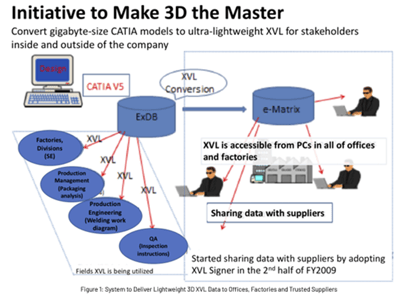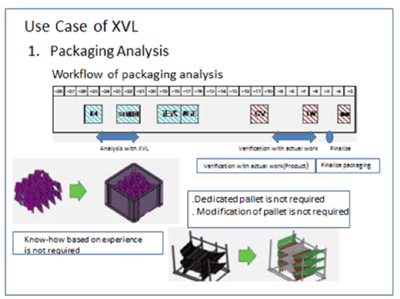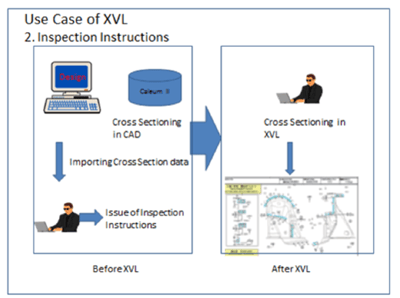Corporate Profile
Toyoda Iron Works Co. Ltd. (TIW) is a tier-one Japanese auto parts supplier founded in 1946. TIW is headquartered in Toyota City and manufactures auto parts in three plants in Japan and 10 plants overseas. Their main products are steel plate body frame components and chassis parts. Seventy-five percent of their production is for Toyota Motor Corporation.
Business Challenges
TIW started the transition from 2D to 3D (CATIA) after 2000. The transition was not easy. Several years later, 3D CAD and CAE were rolled out to limited departments. During that time, there were no company-wide standards for CAD/CAE usage. Even though some departments were using 3D, lack of company-wide standards resulted in a lot of unnecessary rework in the late stages of design and production planning.
Business Strategy and Objectives
Toyota Motor Corporation launched a "3D as the Master" initiative which included providing 3D data to suppliers like TIW. This triggered TIW to launch the Digital and Simultaneous Engineering Initiative (D-SE Initiative).
The goals of the D-SE Initiative were:
- Eliminate design rework.
- Reduce costs due to rework by 80%.
- Reduce the overall lead time from development to production readiness.
To achieve these goals, TIW created a work environment centered on the 3D model, making TIW a model-based enterprise (MBE).
TIW allowed all departments to retrieve the lightweight 3D XVL data directly from the PDM system and use it to improve their own business processes. TIW also shares the XVL data with their own trusted suppliers, enabling more efficient communication.
Using XVL for leveraging 3D data is much easier than using 3D CAD. The main reasons are XVL’s ultralight format that retains CAD-level accuracy and it being CAD-agnostic. Most complete products are segmented into many CAD models and programs for size or working convenience.
Even different CAD formats that might have been gigabyte-sized files are brought together into a single XVL file. These consolidated XVL files are then managed by XVL Content Manager for version control to downstream functions.
TIW achieved great results by building a 3D environment for automatically checking production engineering requirements and performing packaging analysis. They also used XVL and 3D CAD data to improve production efficiency, increase product yield, and to check welding gun accessibility. TIW also uses XVL to virtually validate assembly processes which is much more accurate and efficient than using 2D drawings.
They also use 3D XVL data to improve client communications. The data they receive from their clients is often incomplete; it may be only part data with no assembly information, and often lacks critical properties such as board thickness and material. TIW needs to add the missing properties and build the assemblies for the parts. With XVL, they are now able to add the required properties and build the assemblies as a post-processing task. This gives them the critical information they need to respond to client requests.
While TIW has made progress transitioning to 3D as the Master using XVL, challenges remain. Some divisions still prefer 2D because they have always done things that way and they "don't know how to use 3D." TIW is encouraging more XVL utilization by providing training, leveraging management support, adding new staff, and upgrading PCs.

Packaging Analysis
Packaging products on pallets for delivery to Toyota Motor Corporation was a time-consuming task and if done incorrectly, wastes a lot of money. In the past, TIW determined packaging estimates based on the experience of experts or by extrapolating from similar products after gleaning the length, width, and height from paper drawings. However, these procedures did not provide enough precision required by TIW to validate the actual packaging plans. This took additional labor for prototyping and modification—especially when a dedicated pallet was required.
To make this process more efficient, TIW first tried to use 3D CAD. However, packaging analysis involves testing many arrangements of multiple copies of parts and assemblies. The data demands were very high, especially when using heavy 3D CAD models, and the CAD systems were unable to perform the analysis. After being unsuccessful with 3D CAD, they turned to XVL. TIW started by converting the part and pallet data to XVL. Next, they would open the parts and pallet models in XVL Studio and use the part copy and move functions with dynamic interference checking to make a high-accuracy analysis of the layout. The results were so accurate that it was not necessary to validate using physical prototypes—saving substantial time, labor, and transportation costs.
ROI
Using XVL for packaging analysis reduced the cost for creating dedicated pallets by 30%. In addition, TIW reduced transportation costs and improved the accuracy in packaging analysis in early stages by 13%.
Measurement Instructions and Welding Plans

Quality Control (QC) includes checking the measurements of parts and finished products. However, specifying exactly what needs to be measured can be tricky. That’s why effective QC requires precise measurement instructions. TIW uses XVL to create measurement instructions by cross sectioning the XVL model at the points to be measured and pasting the cross-sections into Excel worksheets.
TIW also uses XVL to validate welding procedures, check for interferences and optimize welding gun usage. This has reduced the time to produce welding plans.

Summary
The benefits of utilizing XVL have driven TIW to the point where they now use 3D for all their main products. However, 3D penetration is not yet 100%—some suppliers and overseas factories still use 2D drawings.
Going forward, TIW plans to expand the use of XVL for worker training, to create common work instructions and to produce 3D documentation for additional stakeholders. To replace 2D drawings for the last holdouts, they expect such documentation to be available on mobile devices such as tablets.

